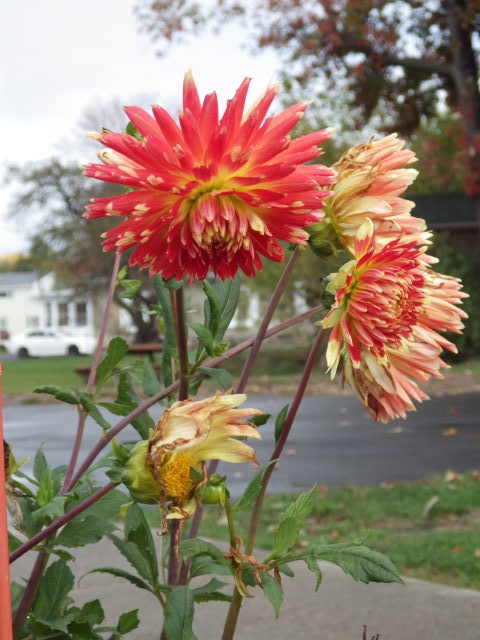|
"Chrysanthemum" comes from the Greek for "gold" and "flower." You know these flowers: big tidy pots of blooms that last for ages. They show up for sale in the front of high-end grocery stores and at the big hardware warehouse stores. Mums, as we call them in English. Mums at Halloween, autumn colors for Thanksgiving. In Australia, mums are the traditional flower for Mother's day. In China, they are the symbol of autumn and purity. The chrysanthemum is the official flower of Chicago. Who knew? In India, a girl wearing chrysanthemums in her hair is said to bring happiness to her family. And in Japan, they represent longevity. The royal family sits on the chrysanthemum throne. But also –– so I understand after reading one of the Sano Ichiru mysteries by Laura Joh Rowland –– it's a symbol of homosexuality in samurai times. Yeah, don't think about it. But in France, they are the flower for tombstones. People put them in the graveyard on All Saints. For years, I have mistakenly believed that Charles Baudelaire's famous book of poetry Les Fleurs du Mal –– a chunk of which I translated in college, for pity's sake –– was both "the flowers of evil" (a metaphor) and also an actual flower: chrysanthemums. Whenever I saw the cheerful round faces of chrysanthemums, my busy brain would supply the subtitle, "Les fleurs du mal!" But nope. Baudelaire anyhow wasn't referencing these particular flowers in his poems about the pursuit of novelty and erotic decadence. How odd: such an infinitesimal and utterly trivial prejudice against an innocent flower, but I have held it for decades. Of course, it's worth remembering that one might also translate the title of that book (which I don't recommend, btw, as fun reading) as "the flowers from evil, or from suffering." Or something. Anyhow. They are long-suffering and colorful blossoms, no matter what I've mistakenly held against them. References
https://www.teleflora.com/meaning-of-flowers/chrysanthemum http://www.thehindu.com/thehindu/mag/2003/02/02/stories/2003020200110400.htm https://www.gardeningchannel.com/top-flowers-for-indian-weddings/ http://www.cerisepress.com/04/10/four-translations-from-les-fleurs-du-mal-by-charles-baudelaire
2 Comments
Goldie
10/8/2018 01:40:47 pm
Mums for Mother's Day?
Reply
Amy
10/9/2018 12:31:33 pm
Hey Goldie.
Reply
Leave a Reply. |
About the Blog
A lot of ground gets covered on this blog -- from sailboat racing to book suggestions to plain old piffle. FollowTrying to keep track? Follow me on Facebook or Twitter or if you use an aggregator, click the RSS option below.
Old school? Sign up for the newsletter and I'll shoot you a short e-mail when there's something new.
Archives
June 2024
Categories
All
|

 RSS Feed
RSS Feed
